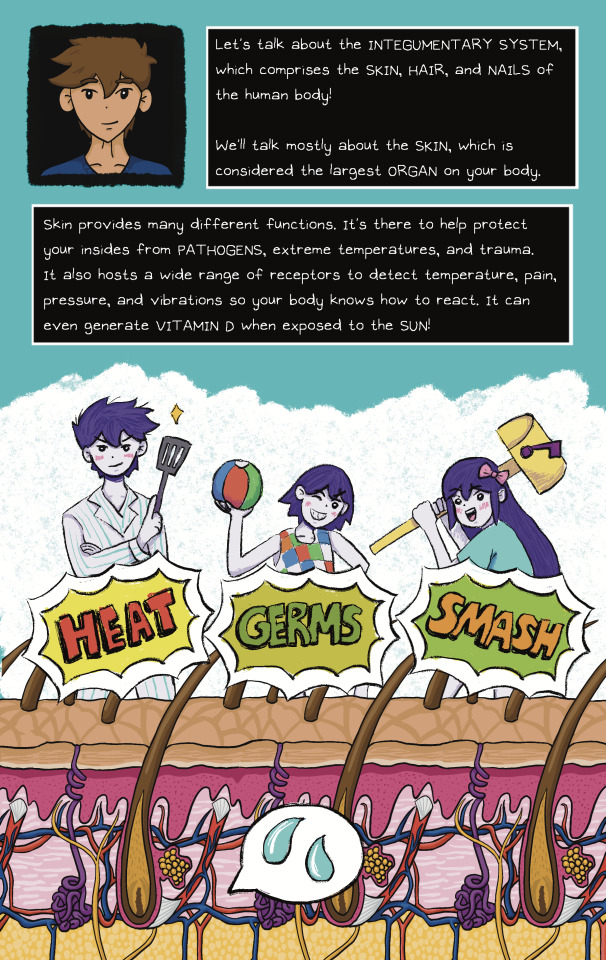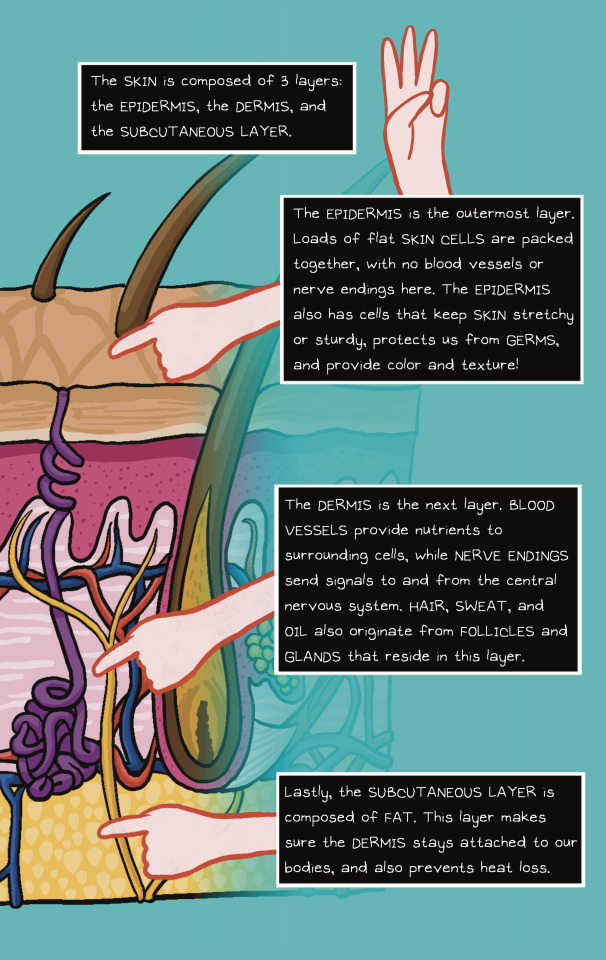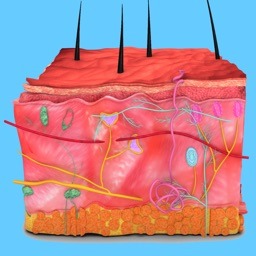#Integumentary system
Text
The Human Body
It comprises living cells and extracellular materials, organized into tissues, organs, and systems.
It is primarily composed of water and organic compounds, lipids, proteins, carbohydrates, and nucleic acids.
Water, making up about 60% (varies by age) of body weight, is crucial for life's chemical processes, found in both extracellular fluids and within cells, serving as a vital solvent.
The skin and related structures form the integumentary system, safeguarding the body from harmful invaders and chemicals while also preventing water loss.
Comprising skeletal muscles and bones (about 206 in adults), the musculoskeletal system facilitates body movement and shields internal organs.
Incorporating breathing passages, lungs, and respiratory muscles, the respiratory system acquires vital oxygen from the air for cellular metabolism and expels waste carbon dioxide.
The circulatory system, comprising the heart, blood, and vessels, circulates fluid throughout the body, furnishing cells with oxygen and nutrients while removing waste like carbon dioxide and toxic compounds.
The digestive system comprises the mouth, esophagus, stomach, and intestines, breaks down food into usable nutrients, absorbing them into the bloodstream, and eliminates the remaining waste as feces.
Consisting of kidneys, ureters, bladder, and urethra, the excretory system filters toxins and waste from the blood for elimination.
The nervous system formed by sensory organs, brain, spinal cord, and nerves transmits sensory data, integrates it, and triggers appropriate muscular or glandular responses.
Composed of hormone-secreting glands and tissues, the endocrine system coordinates body processes via a chemical communication network.
The reproductive system, encompassing male or female sex organs, plays a crucial role in facilitating reproduction.
In males, this system includes structures such as the testes, which produce sperm, and in females, it comprises the ovaries, which produce eggs.
📹 (✏️) : SciePro
#human body#water#skin#musculoskeletal system#respiratory system#circulatory system#digestive system#excretory system#nervous system#endocrine system#reproductive system#integumentary system#science
18 notes
·
View notes
Text
Eccrine Sweat Glands
-- located in the dermis
-- found all over the body
-- begin working immediately following birth
-- produce clear liquid called perspiration
-- perspiration consists of water and salts
-- a type of suderiferous gland
-- more numerous than apocrine sweat glands
#medblr#studyblr#notes#my notes#medical notes#medblr notes#med notes#anatomy and physiology#anatomy#physiology#anatomy notes#physiology notes#eccrine sweat glands#eccrine sweat glands notes#integumentary system#integumentary system notes
10 notes
·
View notes
Photo

Convergence of the self
#my art lol#maplesleep art#digital art#halloween#inktober#body horror#body systems#spooky#ghost#anatomy#integumentary system#horror#Digital Illustration#skeletal system#nervous system#soul#lol so this took much longer than i wanted#hopefully i can get out one more spooky month piece out in time
30 notes
·
View notes
Text




HERO's Incomprehensible Cookbook... of Medicine - featuring the integumentary system!
On the flip side of me learning the musculoskeletal system... there isn't a lot about the integumentary system that 1) I've learned about across a few survey classes, 2) doesn't also include cancer, or 3) doesn't involve very gross-looking symptoms. Or maybe I didn't find this topic particularly interesting lol.
Hero, Kel, and Aubrey are from the RPG OMORI.
11 notes
·
View notes
Text
Integumentary Accessory Structures: Nails
Integumentary Accessory Structures: Nails
Within the integumentary system, four main accessory structures aid in thermoregulation, sense of touch, protection, and much more. These four main accessory structures are:
Hair FolliclesNailsSebaceous GlandsSweat Glands
https://teachmeanatomy.info/upper-limb/misc/nail-unit/
The nails can be found on the tips of your toes and fingers. The main function of these structures is to protect these…

View On WordPress
#accessory structure#anatomy#animals#biology#blog#college#cuticle#dermis#eponychium#facts#fingers#follow#glands#hair#Integumentary system#keratin#lunula#nail bed#nail fold#nail plate#nail root#nails#nature#phalanx#photography#science#subscribe
7 notes
·
View notes
Text

A thing we did in my medical terminology class for the integmentuary system (yeah definitely spelled that wrong)
We used a variety of different candies and a rice Krispy as the base. It is edible and sitting on my desk wrapped in a coloring page.
Sorry for my shitty handwriting lol
2 notes
·
View notes
Text

Thank u Pinterest that's exactly what I want to see. Wesley Crusher, Back to the Future, Star Trek Original, Star Trek Voyager, and ✨integumentary system✨
2 notes
·
View notes
Text
invincibility
hey tumblr, quick question put if someone had semi invulnerability, like their integumentary system like their skin was the only invulnerable part then could they still break a bone?
the bones aren’t invulnerable only like the skin.
this question comes from someone who has never broken a bone so if you could tell me how that also works that would be nice.
this also comes from someone who overthinks things a lot, so I was left with a lot of questions and extremely confused.
Plz help me.
#superpowers#invulnerability#superheroes#bones#how does it work#send help#please#Integumentary system
0 notes
Text

HELL WORLD HELL WORLD HELL WORLD HELL WORLD HELL WORLD HELL WORL-
#lemon time#WHYYYYYY. WHY ARE PEOPLE LIKE THIS.#ITS JUST HAIR. ITS JUST HAIR. LIKE THE HAIR ON YOUR FUCKING HEAD.#DO YOU NOT KNOW THE VALUE BODY HAIR HAS.#ITS SUPPOSED TO KEEP YOU WARM. IT ASSISTS IN THERMOREGULATION.#IT HELPS PROTECT YOU ITS IMPORTANT FOR SKIN HEALTH#BODY HAIR IS IMPORTANT. IT IS IMPORTANT FOR OUR HEALTH.#MY ASS IS NOT BEING HELD AT GUNPOINT TO LEARN ABOUT THE INTEGUMENTARY SYSTEM JUST TO SEE PEOPLE DOING THIS#(also more despairingly: rest of the video is advice on how to lower testosterone count in women. to get rid of body hair.)
1 note
·
View note
Text
i'm almost done with this stupid fucking chapter i just have one quiz and the test left and i can move onnnnnnnnn
#whiny baby post#fuck the integumentary system !!!!#stop having so many things you can have wrong !#and so many ways to fix those things !!!
1 note
·
View note
Text
Hair
-- an accessory organ of the integumentary system
-- hair is made of keratin
-- the hair shaft projects from the skin
-- the root is embedded in the skin
-- the shape of the root determines whether hair is curly or straight
-- pigment (hair color) depends on melanocytes located in the follicle
-- the hair follicle contains the hair root
-- the hair follicle has nerve endings
-- papila = knot of capillaries that supply nutrients
-- arector pili muscles raise the hair
-- the arector pili muscles are made of bundles of smooth muscles
#medblr#studyblr#notes#my notes#medical notes#med notes#medblr notes#anatomy and physiology#anatomy#physiology#anatomy notes#physiology notes#integumentary system#integumentary system notes#hair#hair notes
9 notes
·
View notes
Text
Histology of Integumentary system Notes
#MendelsLaws#HereditaryTraits#ScienceOfInheritance#MendelianInheritance#GeneticDiscoveries#BiologyLessons#MendelsPrinciples#GeneticsEducation#HereditaryScience#Histology of Integumentary system Notes
0 notes
Text
Test Your Knowledge about skin, hair, nails with the Integumentary System Quiz.
Explore the skin you're in with our Integumentary System Quiz! Dive into this interactive experience and test your knowledge about skin, hair, nails, and more. Discover fascinating facts while uncovering the secrets of your body's largest organ system. learn more about the human body.

0 notes
Text
youtube
1 note
·
View note
Text
Subcutaneous Layer
The first layer below the cutaneous membrane is called the subcutaneous layer. It is also known as the hypodermis and superficial fascia. Although this layer helps stabilize the integumentary system and shares some characteristics, it is not technically a part of the integumentary system.
https://my.clevelandclinic.org/health/body/21902-hypodermis-subcutaneous-tissue
Within the subcutaneous…

View On WordPress
#animals#biology#blog#collagen#college#cutaneous membrane#dermis#elastic#epidermis#estrogen#facts#follow#hypodermic needle#hypodermis#Integumentary system#layers of the skin#nature#photography#science#skin#subcutaneous#subscribe#testosterone
3 notes
·
View notes
